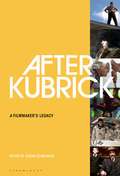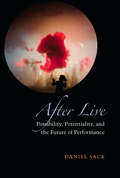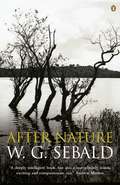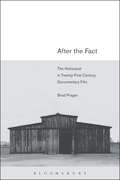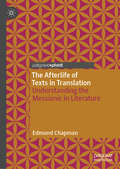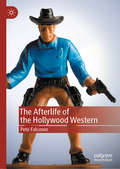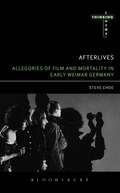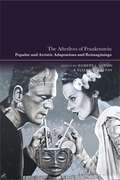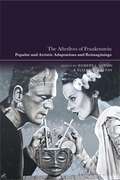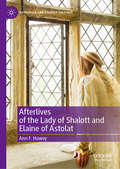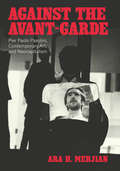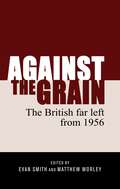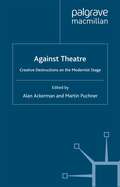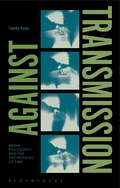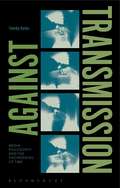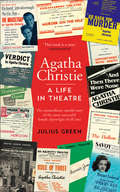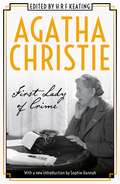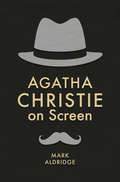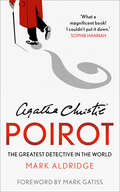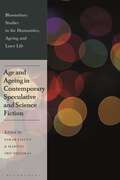- Table View
- List View
After Kubrick: A Filmmaker’s Legacy
by Jeremi SzaniawskiTaking at its starting point the idea that Kubrick's cinema has constituted an intellectual, cerebral, and philosophical maze in which many filmmakers (as well as thinkers and a substantial fringe of the general public) have gotten lost at one point or another, this collection looks at the legacy of Kubrick's films in the 21st century.The main avenues investigated are as follows: a look at Kubrick's influence on his most illustrious followers (Paul Thomas Anderson, the Coen Brothers, Christopher Nolan, Ridley Scott, and Lars von Trier, to name a few); Kubrick in critical reception; Kubrick in stylistic (camera movements, set designs, music), thematic (artificial intelligence, new frontiers- large and small), aesthetic (the question of genre, pastiche, stereoscopy) and political terms (paranoia, democracy and secret societies, conspiracy theories). The contributions coalesce around the concept of a Kubrickian substrate, rich and complex, which permeates our Western cultural landscape very much to this day, informing and sometimes announcing/reflecting it in twisted ways, 21 years after the director's death.
After Kubrick: A Filmmaker’s Legacy
Taking at its starting point the idea that Kubrick's cinema has constituted an intellectual, cerebral, and philosophical maze in which many filmmakers (as well as thinkers and a substantial fringe of the general public) have gotten lost at one point or another, this collection looks at the legacy of Kubrick's films in the 21st century.The main avenues investigated are as follows: a look at Kubrick's influence on his most illustrious followers (Paul Thomas Anderson, the Coen Brothers, Christopher Nolan, Ridley Scott, and Lars von Trier, to name a few); Kubrick in critical reception; Kubrick in stylistic (camera movements, set designs, music), thematic (artificial intelligence, new frontiers- large and small), aesthetic (the question of genre, pastiche, stereoscopy) and political terms (paranoia, democracy and secret societies, conspiracy theories). The contributions coalesce around the concept of a Kubrickian substrate, rich and complex, which permeates our Western cultural landscape very much to this day, informing and sometimes announcing/reflecting it in twisted ways, 21 years after the director's death.
After Live: Possibility, Potentiality, and the Future of Performance (Theater: Theory/Text/Performance)
by Daniel A SackIn the dark of the blackout before the curtain rises, the theater holds its many worlds suspended on the verge of appearance. How can a performance sustain this sense of potentiality that grounds all live production? Or if a stage-world does begin, what kinds of future might appear within its frame? Conceiving of the theater as a cultural institution devoted to experimenting with the future, this book begins and ends on the dramatic stage; in between it traverses literature, dance, sculpture, and performance art to explore the various futures we make in a live event. After Live conceives of traditional dramatic theater as a place for taming the future and then conceptualizes how performance beyond this paradigm might stage the unruly nature of futurity. Chapters offer insights into the plays of Beckett, Churchill, Eno, and Gombrowicz, devised theater practices, and include an extended exploration of the Italian director Romeo Castellucci. Through the lens of potentiality, other chapters present novel approaches to minimalist sculpture and dance, then reflect on how the beholder him or herself is called upon to perform when confronted by such work.
After Nature
by W. G. SebaldAfter Nature is the very first literary work by W. G. Sebald, author of AusterlitzAfter Nature by W.G. Sebald, author of Austerlitz, is his first literary work and the start of his highly personal and brilliant writing journey. In this long prose poem, Sebald introduces many of the themes that he explores in his subsequent books. Focusing on the conflict between man and nature, each of the three distinct parts of After Nature give centre stage to a different character from a different century - the last being W.G. Sebald himself.'A deeply intelligent book, but also a marvellously warm, exciting and compassionate one' Andrew Motion'A début of rare poetic grandeur' Irish Times'Astonishing writing. A true poet at work' Evening Standard'Graceful, allusive, serious, but also immensely readable' Sunday Telegraph'When you read Sebald you are transported to another realm' Literary ReviewW . G. Sebald was born in Wertach im Allgäu, Germany, in 1944 and died in December 2001. He studied German language and literature in Freiburg, Switzerland and Manchester. In 1996 he took up a position as an assistant lecturer at the University of Manchester and settled permanently in England in 1970. He was Professor of European Literature at the University of East Anglia and is the author of The Emigrants, The Rings of Saturn, Vertigo, Austerlitz, After Nature, On the Natural History of Destruction, Campo Santo, Unrecounted, For Years Now and A Place in the Country. His selected poetry is published in a volume called Across the Land and the Water.
After the Fact: The Holocaust in Twenty-First Century Documentary Film
by Brad PragerAfter the Fact studies the terrain of Holocaust documentaries subsequent to the turn of the twenty-first century. Until now most studies have centered primarily on canonical films such as Shoah and Night and Fog, but over the course of the last ten years filmmaking practices have altered dramatically. Changing techniques, diminishing communities of survivors, and the public's response to familiar, even iconic imagery, have all challenged filmmakers to radically revise and newly envision how they depict the Holocaust. Innovative styles have emerged, including groundbreaking techniques of incorporating archival footage, survivor testimony, and reenactment. Carrying wider implications for the fields of Film Studies, Jewish Studies, and Visual Studies, this book closely analyzes ten contemporary and internationally produced films, most of which have hardly been touched upon in the critical literature or elsewhere.
After the Fact: The Holocaust in Twenty-First Century Documentary Film
by Brad PragerAfter the Fact studies the terrain of Holocaust documentaries subsequent to the turn of the twenty-first century. Until now most studies have centered primarily on canonical films such as Shoah and Night and Fog, but over the course of the last ten years filmmaking practices have altered dramatically. Changing techniques, diminishing communities of survivors, and the public's response to familiar, even iconic imagery, have all challenged filmmakers to radically revise and newly envision how they depict the Holocaust. Innovative styles have emerged, including groundbreaking techniques of incorporating archival footage, survivor testimony, and reenactment. Carrying wider implications for the fields of Film Studies, Jewish Studies, and Visual Studies, this book closely analyzes ten contemporary and internationally produced films, most of which have hardly been touched upon in the critical literature or elsewhere.
The Afterlife of Texts in Translation: Understanding the Messianic in Literature
by Edmund ChapmanThe Afterlife of Texts in Translation: Understanding the Messianic in Literature reads Walter Benjamin’s and Jacques Derrida’s writings on translation as suggesting that texts exist within a process of continual translation. Understanding Benjamin’s and Derrida’s concept of ‘afterlife’ as ‘overliving’, this book proposes that reading Benjamin’s and Derrida’s writings on translation in terms of their wider thought on language and history suggests that textuality itself possesses a ‘messianic’ quality. Developing this idea in relation to the many rewritings and translations of Don Quijote, particularly the multiple rewritings by Jorge Luis Borges, Edmund Chapman asserts that texts consist of a structure of potential for endless translation that continually promises the overcoming of language, history and textuality itself.
The Afterlife of the Hollywood Western
by Pete FalconerThis book examines the Western genre in the period since Westerns ceased to be a regular feature of Hollywood filmmaking. For most of the 20th Century, the Western was a major American genre. The production of Westerns decreased in the 1960s and 1970s; by the 1980s, it was apparent that the genre occupied a less prominent position in popular culture. After an extended period as one of the most prolific Hollywood genres, the Western entered its “afterlife”. What does it now mean for a Hollywood movie to be a Western, and how does this compare to the ways in which the genre has been understood at other points in its history? This book considers the conditions in which the Western has found itself since the 1980s, the latter-day associations that the genre has acquired and the strategies that more recent Westerns have developed in response to their changed context.
Afterlives: Allegories Of Film And Mortality In Early Weimar Germany (Thinking Cinema)
by Steve ChoeWeimar cultural critics and intellectuals have repeatedly linked the dynamic movement of the cinema to discourses of life and animation. Correspondingly, recent film historians and theorists have taken up these discourses to theorize the moving image, both in analog and digital. But, many important issues are overlooked. Combining close readings of individual films with detailed interpretations of philosophical texts, all produced in Weimar Germany immediately following the Great War, Afterlives: Allegories of Film and Mortality in Early Weimar Germany shows how these films teach viewers about living and dying within a modern, mass mediated context. Choe places relatively underanalyzed films such as F. W. Murnau's The Haunted Castle and Arthur Robison's Warning Shadows alongside Martin Heidegger's early seminars on phenomenology, Sigmund Freud's Reflections upon War and Death and Max Scheler's critique of ressentiment. It is the experience of war trauma that underpins these correspondences, and Choe foregrounds life and death in the films by highlighting how they allegorize this opposition through the thematics of animation and stasis.
Afterlives: Allegories Of Film And Mortality In Early Weimar Germany (Thinking Cinema)
by Steve ChoeWeimar cultural critics and intellectuals have repeatedly linked the dynamic movement of the cinema to discourses of life and animation. Correspondingly, recent film historians and theorists have taken up these discourses to theorize the moving image, both in analog and digital. But, many important issues are overlooked. Combining close readings of individual films with detailed interpretations of philosophical texts, all produced in Weimar Germany immediately following the Great War, Afterlives: Allegories of Film and Mortality in Early Weimar Germany shows how these films teach viewers about living and dying within a modern, mass mediated context. Choe places relatively underanalyzed films such as F. W. Murnau's The Haunted Castle and Arthur Robison's Warning Shadows alongside Martin Heidegger's early seminars on phenomenology, Sigmund Freud's Reflections upon War and Death and Max Scheler's critique of ressentiment. It is the experience of war trauma that underpins these correspondences, and Choe foregrounds life and death in the films by highlighting how they allegorize this opposition through the thematics of animation and stasis.
The Afterlives of Frankenstein: Popular and Artistic Adaptations and Reimaginings
by Robert I. Lublin and Elizabeth A. FayAn exploration of the treatment of Mary Shelley's Frankenstein in popular art and culture, this book examines adaptations in film, comics, theatre, art, video-games and more, to illuminate how the novel's myth has evolved in the two centuries since its publication. Divided into four sections, The Afterlives of Frankenstein considers the cultural dialogues Mary Shelley's novel has engaged with in specific historical moments; the extraordinary examples of how Frankenstein has suffused our cultural consciousness; and how the Frankenstein myth has become something to play with, a locus for reinvention and imaginative interpretation. In the final part, artists respond to the Frankenstein legacy today, reintroducing it into cultural circulation in ways that speak creatively to current anxieties and concerns.Bringing together popular interventions that riff off Shelley's major themes, chapters survey such works as Frankenstein in Baghdad, Bob Dylan's recent “My Own Version of You”, the graphic novel series Destroyer with its Black cast of characters, Jane Louden's The Mummy!, the first Japanese translation of Frankenstein, “The New Creator”, the iconic Frankenstein mask and Kenneth Brannagh's Mary Shelley's Frankenstein film. A deep-dive into the crevasses of Frankenstein adaptation and lore, this volume offers compelling new directions for scholarship surrounding the novel through dynamic critical and creative responses to Shelley's original.
The Afterlives of Frankenstein: Popular and Artistic Adaptations and Reimaginings
An exploration of the treatment of Mary Shelley's Frankenstein in popular art and culture, this book examines adaptations in film, comics, theatre, art, video-games and more, to illuminate how the novel's myth has evolved in the two centuries since its publication. Divided into four sections, The Afterlives of Frankenstein considers the cultural dialogues Mary Shelley's novel has engaged with in specific historical moments; the extraordinary examples of how Frankenstein has suffused our cultural consciousness; and how the Frankenstein myth has become something to play with, a locus for reinvention and imaginative interpretation. In the final part, artists respond to the Frankenstein legacy today, reintroducing it into cultural circulation in ways that speak creatively to current anxieties and concerns.Bringing together popular interventions that riff off Shelley's major themes, chapters survey such works as Frankenstein in Baghdad, Bob Dylan's recent “My Own Version of You”, the graphic novel series Destroyer with its Black cast of characters, Jane Louden's The Mummy!, the first Japanese translation of Frankenstein, “The New Creator”, the iconic Frankenstein mask and Kenneth Brannagh's Mary Shelley's Frankenstein film. A deep-dive into the crevasses of Frankenstein adaptation and lore, this volume offers compelling new directions for scholarship surrounding the novel through dynamic critical and creative responses to Shelley's original.
Afterlives of the Lady of Shalott and Elaine of Astolat (Arthurian and Courtly Cultures)
by Ann F. HoweyThis book investigates adaptations of The Lady of Shalott and Elaine of Astolat in Victorian and post-Victorian popular culture to explore their engagement with medievalism, social constructions of gender, and representations of the role of art in society. Although the figure of Elaine first appeared in medieval texts, including Malory’s Le Morte Darthur, Tennyson’s poems about the Lady and Elaine drew unprecedented response from musicians, artists, and other authors, whose adaptations in some cases inspired further adaptations. With chapters on music, art, and literature (including parody, young people’s literature, and historical fiction and fantasy), this book seeks to trace the evolution of these characters and the ways in which they reinforce or challenge conventional gender roles, represent the present’s relationship to the past, and highlight the power of art.
Against the Avant-Garde: Pier Paolo Pasolini, Contemporary Art, and Neocapitalism
by Ara H. MerjianRecognized in America chiefly for his films, Pier Paolo Pasolini (1922–1975) in fact reinvented interdisciplinarity in postwar Europe. Pasolini self-confessedly approached the cinematic image through painting, and the numerous allusions to early modern frescoes and altarpieces in his films have been extensively documented. Far less understood, however, is Pasolini’s fraught relationship to the aesthetic experiments of his own age. In Against the Avant-Garde, Ara H. Merjian demonstrates how Pasolini’s campaign against neocapitalist culture fueled his hostility to the avant-garde. An atheist indebted to Catholic ritual; a revolutionary communist inimical to the creed of 1968; a homosexual hostile to the project of gay liberation: Pasolini refused the politics of identity in favor of a scandalously paradoxical practice, one vital to any understanding of his legacy. Against the Avant-Garde examines these paradoxes through case studies from the 1960s and 1970s, concluding with a reflection on Pasolini’s far-reaching influence on post-1970s art. Merjian not only reconsiders the multifaceted work of Italy’s most prominent postwar intellectual, but also the fraught politics of a European neo-avant-garde grappling with a new capitalist hegemony.
Against the grain: The British far left from 1956 (PDF)
by Evan Smith Matthew WorleyAgainst the grain is the first general history of the British far left to be published in the twenty-first century. Its contents cover a range of organisations beyond the Labour Party, bringing together leading experts on British left-wing politics to examine issues of class, race and gender from 1956 to the present day. The essays collected here are designed to highlight the impact made by the far left on British politics and society. Though the predicted revolution did not come, organisations such as the International Socialists, the International Marxist Group and Militant became household names in the 1970s and 1980s. Taken as a whole, the collection demonstrates the extent to which the far left has weaved its influence into the political fabric of Britain.
Against the grain: The British far left from 1956
by Evan Smith Matthew WorleyAgainst the grain is the first general history of the British far left to be published in the twenty-first century. Its contents cover a range of organisations beyond the Labour Party, bringing together leading experts on British left-wing politics to examine issues of class, race and gender from 1956 to the present day. The essays collected here are designed to highlight the impact made by the far left on British politics and society. Though the predicted revolution did not come, organisations such as the International Socialists, the International Marxist Group and Militant became household names in the 1970s and 1980s. Taken as a whole, the collection demonstrates the extent to which the far left has weaved its influence into the political fabric of Britain.
Against Theatre: Creative Destructions on the Modernist Stage (Performance Interventions)
by A. Ackerman M. PuchnerAgainst Theatre shows that the most prominent writers of modern drama shared a radical rejection of the theatre as they knew it. Together with designers, composers and film makers, they plotted to destroy all existing theatres. But from their destruction emerged the most astonishing innovations of modernist theatre.
Against Transmission: Media Philosophy and the Engineering of Time (PDF)
by Timothy BarkerIn Against Transmission Barker rethinks the history of audio-visual media as a history of analytical instruments. Rather than viewing media history as the commonly told story of synthetic media (media that make a new whole from connecting separate parts), by focusing on the analytical function of mediation Against Transmission is able to focus on the way that media that have historically been used to count, measure and analyse experience still continue to provide the condition for contemporary life. By studying the engineering of transmission, transduction and storage through the prism of process philosophy, the book interrogates how the understanding of media-as-machine may offer new ways to describe a particular phenomenological relationship to the world, asking: what can the hardware of machines that segment information into very small elements tell us about experiences of time, memory and history? This book offers both a detailed and radical investigation of the technical architecture of media such as television, computers, cameras, and cinematography. It achieves this through in-depth archive research into the history of the development of media technology, combined with innovative readings of key concepts from philosophers of media such as Harold A. Innis, Marshall McLuhan, Friedrich Kittler, Siegfried Zielinski and Wolfgang Ernst. Teaming philosophical inquiry with thorough technical and historical analysis, in a broad range of international case studies, from early experimental cinema and television to contemporary media art and innovative hardware developments, Barker shows how the technical discoveries made in these contexts have engineered the experiences of time in contemporary media culture.
Against Transmission: Media Philosophy and the Engineering of Time
by Timothy BarkerIn Against Transmission Barker rethinks the history of audio-visual media as a history of analytical instruments. Rather than viewing media history as the commonly told story of synthetic media (media that make a new whole from connecting separate parts), by focusing on the analytical function of mediation Against Transmission is able to focus on the way that media that have historically been used to count, measure and analyse experience still continue to provide the condition for contemporary life. By studying the engineering of transmission, transduction and storage through the prism of process philosophy, the book interrogates how the understanding of media-as-machine may offer new ways to describe a particular phenomenological relationship to the world, asking: what can the hardware of machines that segment information into very small elements tell us about experiences of time, memory and history? This book offers both a detailed and radical investigation of the technical architecture of media such as television, computers, cameras, and cinematography. It achieves this through in-depth archive research into the history of the development of media technology, combined with innovative readings of key concepts from philosophers of media such as Harold A. Innis, Marshall McLuhan, Friedrich Kittler, Siegfried Zielinski and Wolfgang Ernst. Teaming philosophical inquiry with thorough technical and historical analysis, in a broad range of international case studies, from early experimental cinema and television to contemporary media art and innovative hardware developments, Barker shows how the technical discoveries made in these contexts have engineered the experiences of time in contemporary media culture.
Agatha Christie: Agatha Christie - A Life In The Theatre
by Julius GreenA revealing and witty new examination of how Agatha Christie became the world’s most successful and popular female playwright, including details of never-before-published scripts and stories.
Agatha Christie: First Lady of Crime
by Agatha ChristieIncludes a new introduction from Sophie Hannah, bestselling author of THE MONOGRAM MURDERSAgatha Christie was not only the biggest selling writer of detective stories the world has ever known, she was also a mystery in herself, giving only the rarest interviews, declining absolutely to become any sort of public figure, and a mystery too in the manner in which she achieved her astonishing success.H R F Keating, a crime novelist and respected reviewer of crime fiction, brought together a dozen distinguished writers from both sides of the Atlantic to throw light on this double mystery. Some analyse the art itself; some explain the reasons for her success, not just the books, but also in film and theatre.The approaches are penetrating, affectionate, enthusiastic, analytical, funny - even critical. Together, they give an almost unique insight into the life and work of the First Lady of Crime.
Agatha Christie on Screen (Crime Files)
by Mark AldridgeThis book is a comprehensive exploration of 90 years of film and television adaptations of the world’s best-selling novelist’s work. Drawing on extensive archival material, it offers new information regarding both the well-known and forgotten screen adaptations of Agatha Christie’s stories, including unmade and rare adaptations, some of which have been unseen for more than half a century. This history offers intriguing insights into the discussions and debates that surrounded many of these screen projects – something that is brought to life through previously unpublished correspondence from Christie herself and a new wide-ranging interview with her grandson, Mathew Prichard. Agatha Christie on Screen takes the reader on a journey from little known silent film adaptations, through to famous screen productions including 1974’s Murder on the Orient Express, as well as the television series of the Poirot and Miss Marple stories and, most recently, the BBC’s acclaimed version of And Then There Were None.
Agatha Christie’s Marple: Expert on Wickedness
by null Mark AldridgeA new investigation from Dr Mark Aldridge, exploring a lifetime of Agatha Christie’s Miss Jane Marple. In Agatha Christie’s Marple: Expert on Wickedness,‘Agathologist’ Dr Mark Aldridge looks at nearly a century of St Mary Mead’s most famous resident and uses his own detective skills to uncover new information about Miss Jane Marple’s appearances on page, stage, screen and beyond. Drawing on a range of material, some of which is newly discovered and previously unpublished, this book explores everything about Miss Marple, from her origins in a series of short stories penned by Christie, to the recent bestselling HarperCollins collection Marple: Twelve New Stories. This accessible, entertaining and illustrated guide to the world of Miss Marple pieces together the evidence in order to tell you everything you need to know about the world’s favourite female detective.
Agatha Christie’s Poirot: The Greatest Detective In The World
by Mark AldridgeFrom the very first book publication in 1920 to the film release of Death on the Nile in December 2020, this investigation into Agatha Christie’s Hercule Poirot celebrates a century of probably the world’s favourite fictional detective.
Age and Ageing in Contemporary Speculative and Science Fiction (Bloomsbury Studies in the Humanities, Ageing and Later Life)
by Sarah Falcus and Maricel Oró-PiquerasFocusing on the contemporary period, this book brings together critical age studies and contemporary science fiction to establish the centrality of age and ageing in dystopian, speculative and science-fiction imaginaries. Analysing texts from Europe, North America and South Asia, as well as television programmes and films, the contributions range from essays which establish genre-based trends in the representation of age and ageing, to very focused studies of particular texts and concerns. As a whole, the volume probes the relationship between speculative/science fiction and our understanding of what it is to be a human in time: the time of our own lives and the times of both the past and the future.
